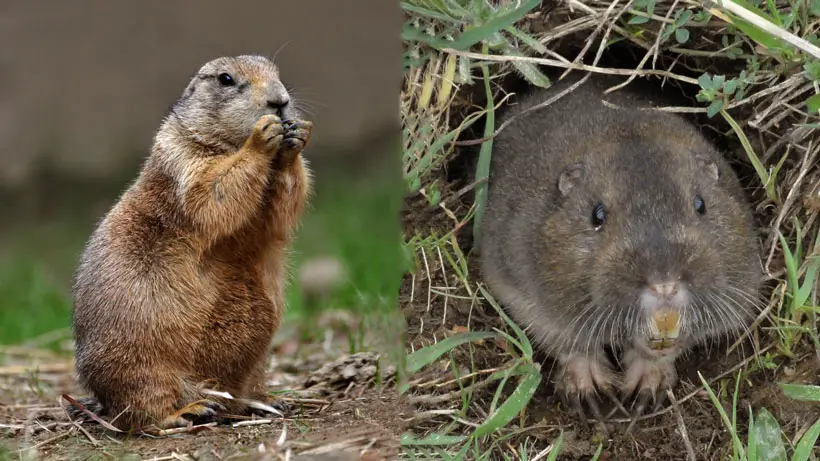Prairie Dog vs Gopher: What’s the Difference?
A prairie dog is a member of the Sciuridae family of squirrels. Prairie dogs are found throughout North America, mostly in the central and western regions, where grasslands and meadows have sparse vegetation.
As cute as they may seem with their tan-brown fur and distinctive black-tipped tails, they are pests that damage the structural integrity of buildings. And they do it by burrowing deep tunnels and competing for grazing land with livestock.
Gophers prefer grasslands, forests, and deserts across North and Central America. They are burrowing animals; out of the 41 species, some create burrows up to 200 meters in length.
These pests cause significant damage to lawns, crops, and gardens through borrowing and vegetative consumption. Management strategies of the two pests differ as they exhibit different practices and differ in the extent of damage they cause.
However, there are many differences to reckon with while talking about prairie dogs vs gophers. But the primary difference is that prairie dogs can be twice in size as gophers.
Hence, in this article, we’ll go over the physical and behavioral differences that will help you identify these animals. Also, we’ll take a look at their habitat preferences.
Brief Look At Prairie Dog vs Gopher
The following table will give you a brief understanding of the differences between these two rodents.
| Characteristics | Prairie dog | Gopher |
|---|---|---|
| Size | 12 to 16 in | 6 to 12 in |
| Weight | Up to 3 lbs. | 1 lb. approx. |
| Fur | Coarse brownish-graywith lighter underbellies | Soft, exhibiting a variety of colors, including black, brown, and gray |
| Tail | Short and bushy | Commonly hairless and sleek |
| Behavior and Activity | Social, feed above ground, communicate with members of the colony and exhibit altruistic characteristics. | Solitary animals, remain underground most of the time, care for the young, and fiercely protect their territory. |
| Communication | Through calls of various kinds sounding like barks, yips, or chirps. | Uses scent to communicate. |
| Habitat | Grassland and meadows with sparse vegetation | woodlands, forests, and grasslands densely packed with vegetation |
Prairie Dogs Vs. Gophers: Physical Characteristics
Even though both animals look similar, you’ll notice differences in fur color and tail type. But most notable of all is their difference in size.

Size
Prairie dogs are larger. Adults are 12-16 inches long and can weigh up to 3 pounds. On the other hand, Gophers only weigh about a pound and grow up to 6-12 inches.
Fur Color
Regarding fur, prairie dogs have coarse brownish-gray fur with an underbelly that is lighter in color.
Grophers’ fur is soft, exhibiting various colors, including black, brown, and gray. Some species have distinct spots and marks on the fur.

Tail
Gophers have sleek tails with fur the same color as the rest of their body. Some even have no fur on their tails at all.
In contrast, a prairie dog has a short, bushy tail tipped with black at the end. They like to use their tails to communicate with their social group.
In addition to their physical characteristics, their burrowing habits also differ.
Burrowing System
Prairie dogs build burrowing networks that are complex, with multiple entries and exits, covering large areas and several meters underground. Their homes have open entrances, so they can house animals like snakes, rabbits, and burrowing owls.

Grophers build smaller burrows with limited openings which they close. So, the chances of other animals living there are less. Their burrows are also much deeper than prairie dogs, with a central tunnel branching off into lateral tunnels built for the purpose of nesting and storage.
Purpose/Use of Their Burrows
Prairie dog burrow systems are also more complex, marking the extent of behavioral differences between the two animals.
Prairie not only uses it for sleeping, storing food, and raising young but also has separate chambers for different types of communication. They have distinctive mating calls, alarm calls, and even greeting calls.
They also use their burrows to escape predators and regulate body temperature. Grophers also use their burrows for these two purposes. Primarily, they store food and nest in their burrows.
Upkeep Outside The Burrow
One of the differences between prairie dogs and gophers is the length of grass outside their burrows. Prairie dogs keep the grass near their burrows short to observe predators. Gophers don’t trim the grass.

However, you’ll find bounds of dirt surrounding the burrow entrance of both animals. This is a way for them to protect their homes from flooding.
It’s obvious that their burrowing system makes the foundation of buildings weak. This can result in the collapse of sheds, patios, and fences by making them unstable.
They not only damage land but also ruin crops that can distress homeowners and farmers alike. Not to mention, the mounds of dirt that protect their burrows look unsightly.
If you spot any signs of burrowing in your land, you should contact companies that provide wildlife management services.
Behavioral Differences Between Prairie Dogs And Gophers
There are many behavioral differences between these rodents. Let’s take a look at how you can differentiate between the two based on their act.

Social Behavior And Communication
Prairie dogs are social animals living in towns that can consist of hundreds of individuals. On the other hand, gophers are solitary animals that take part in limited social interaction.
Here’s a look at the social actions that prairie dogs exhibit.
Communication
The most interesting behavior of prairie dogs is their call which sounds like barks, yips, and even chirps. Because of their calls, these rodents are called dogs.

On the other hand, gophers communicate with other gophers that may enter their territory through scents.
It’s a way of safeguarding their home, of which gophers are extremely protective. These scents inform other gophers about territorial boundaries, reproductive status, etc.
Altruistic Behavior Prairie Dog Exhibits
They exhibit altruistic manners by informing others of predators through their calls, even when that poses a danger to themselves.
Prairie dogs also share food and cooperative breeding. They show playful conduct known as “jump-yipping,” which seems to bond individuals.
Hierarchy In Communities
Prairie dogs are highly social in a hierarchical society where the dominant gets the best resources. Subordinate prairie dogs also play their role in their communities.

Gophers, on the other hand, like solitude. Here are some of the social practices these animals engage in.
Taking Care of Their Youngs
They take care of their young by building them a nest with vegetation and fur. Growing up young, they learn this from their mother and cooperate.
However, after a certain age, they leave their mother and move on to build their own burrows.
Foraging and Caching Behavior
They spend significant time searching for, consuming, and storing food. Their foraging and caching behavior can be compared as follows.

Food Sources
Prairie dogs’ food sources include selective grasses, forbs, shrubs, etc. They can feed on vegetation close to their burrow as well as travel further in groups.
In contrast, gophers spend the majority of their time underground, and they forage for roots, tubers, and other materials found underground.
Foraging Techniques
Prairie dogs, these garden pests, use different communication strategies to overcome the threat of predators while foraging.
They use their sense of smell to locate food items and use their incisor teeth to cut them off at the base. They also sometimes clip the top of grasses and carry them in their cheek pockets back to the burrow for storing or consuming.
In contrast, with their powerful front teeth, gophers dig tunnels and burrows while foraging. They use not only their sense of smell but also touch and taste to assess their food.
Caching Behavior of Prairie Dogs and Gophers
For storage, prairie dogs select grasses high in nutrition and water content. These get them through the winter months when food is scarce.
They also store bedding material. Interestingly, prairie dogs share their caches with their colony.

Gophers store much more food than prairie dogs, even up to several pounds.
While prairie dogs have communal food chambers, gophers store food in a small chamber in their burrow and pack it tightly with dirt to protect their food. Needless to say, gophers forage alone and don’t share food.
Feeding Habits of Prairie Dogs and Gophers
Prairie dogs rely on ground vegetation like grasses and shrubs. At the same time, gophers prefer roots, bulbs, tubers, and other parts that they can access underground.
The diet of prairie dogs consists of fresh and high-quality vegetation to meet nutritional needs, while gophers prefer a fiber-rich and protein-scarce diet.
Prairie dogs eat over the ground in open fields or meadows. In contrast, gophers mostly eat underground but may sometimes look for vegetables outside their burrow at night.
Habitat Preferences of Prairie Dogs And Gophers
There are differences between the kind of habitats these backyard pests prefer. Based on the environment you live in, you can tell whether prairie dogs are infesting it or gophers.

Habitat preference is a way pest control companies identify which animal is the problem. For example, prairie dogs are very unlikely to be found in lawns and gardens. In contrast, gophers are a frequent issue.
Habitat Preferences
Prairie dog species prefer open grasslands or meadows that have a sparse vegetative placement. This allows them to keep an eye on predators and easy communication between members of the colony. As they feed on fresh vegetation, they prefer habitats that have a constant supply.
On the other hand, gopher feeding habits are different. They prefer densely packed, deep-rooted vegetables that are found in woodlands, forests, and grasslands with species of grasses that grow tall.

They can thrive in environments of a variety of moisture levels and soil types.
Even though both live in burrows and are herbivores, their difference in habitat preferences is a testament to their different evolutionary history.
Geographic Distribution
Gophers are distributed more widely as they are more adaptable to different habitats, whereas prairie dogs survive in prairies and grasslands.
You can find gophers in different types of habitats from Central America to Canada. They are found in central, western, and southeastern regions of the United States, Mexico, Columbia, Guatemala, Honduras, etc.
There are 41 gopher species that can thrive as long as there is ample and dense vegetation to ensure their food security. Due to their resilience, they’ve achieved such wide geographical expansion.
Prairie dogs are limited to North America. As we already mentioned, they thrive in open grasslands and prairies that have sparse vegetation. There are only 5 species:
- Gunnison’s
- Black-tailed
- White-tailed
- Utah
- Mexican prairie dogs.
They are found primarily in Northern Mexican states. In the US, they are mostly found in regions to the west of Mississippi and in some eastern parts of the country. Canadian Prairies also house prairie dogs.
Human Influence On The Habitats of Prairie Dogs and Gophers
Prairie dogs and gophers play their part in an ecosystem by promoting nutrient cycling and aerating the soil. But human activities like urbanization, farming, or grazing, have reduced their range and numbers.

As these animals are considered pests, we engage in baiting them for pest prevention, further endangering them directly.
Conserving their species will have positive impacts such as biodiversity and resilience of grassland ecosystems and increased soil health.
Prairie dogs and gophers are both types of rodents that can cause significant damage to your yard. If you want to learn more about the physical characteristics of gophers or how they compare to chipmunks, be sure to check out our articles on what gophers look like and chipmunk vs gopher. Our piece on what gophers look like provides an in-depth look at their appearance, while our article on chipmunk vs gopher offers a comparison between these two species.FAQs
Here are some of the common questions people ask when it comes to prairie dogs vs gophers.
Q. Can prairie dogs and gophers interbreed?
No, that’s not possible, as they belong to different species and don’t have genetically compatible compositions.
Prairie dogs have similar characteristics to squirrels and belong to the Sciuridae family, while gophers are members of the Geomyidae family.
Q. Are prairie dogs and gophers harmful to humans?
Prairie dogs can be directly harmful to humans as they are hosts to plague-infected fleas.
Both animals, however, are harmful to different human activities, like agriculture and farming. They also damage human dwellings.
Q. How do prairie dogs and gophers differ in their impact on gardens and lawns?
Both wreak similar havoc by destroying plants, burrowing underground, and creating mounds of soil that look ugly.
But Prairie dogs don’t usually live in gardens and lawns. They prefer grasslands. So, gophers are a bigger threat as those infestations are more commonplace.
Final Words
Prairie dogs and gophers may have ecological similarities, but they are very different genetically. That’s why you’ll spot many differences when you take a look at their physical and behavioral characteristics as well as habitat preferences.
The easiest way to distinguish between prairie dogs vs gophers is their size and tail. Prairie dogs are much larger than gophers, and they have short and bushy tails.
On the other hand, gophers have sleek tails. You’re also unlikely to spot gophers as they spend most of their time underground, while prairie dogs forage in groups.
Moreover, prairie dogs are confined to grasslands, while gophers prefer lawns and gardens as well. The point of differentiating between the two is to ensure that you take the right pest management measures.
A targeted management strategy can be designed only when you know the species, habitat, and food preference of the pest in question.
Common preventive strategies include reducing the availability of food by removing vegetation, installing barriers like underground mesh, fencing, or netting. You can also apply chemical repellents like castor oil or capsaicin.




